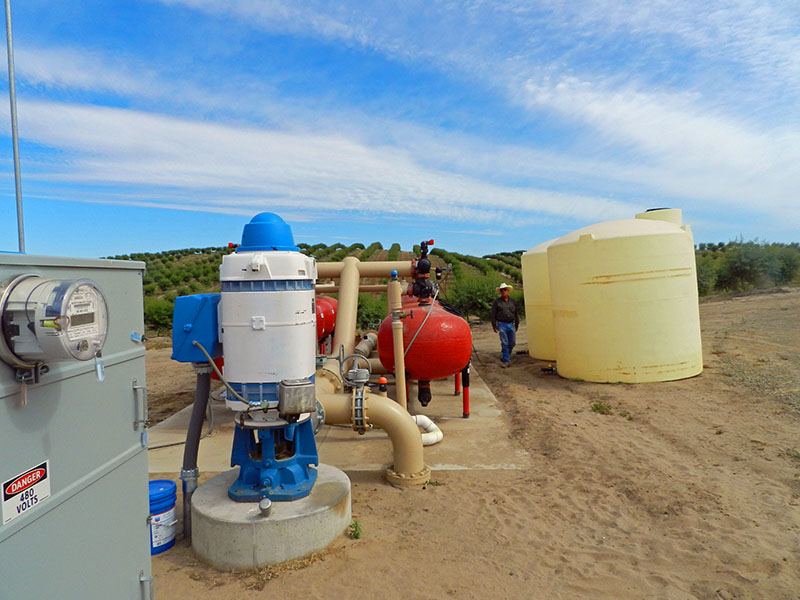
If one wants to know how bad a drought is, ask someone whose business it is to plumb the water table and test the effectiveness of wells and pumps. A gentleman in the business told this writer that he is busier than ever.
Businesses that rely on well water need to keep the water flowing. Wells need testing to make sure they don’t go dry and to check pumps for operational efficiency so that they don’t waste electricity or burn out. During a drought, testing is critical for economic survival. If a well goes dry, the landowner may go out of business.
The Increasing Importance of Testing Wells
The well tester I spoke with checks wells from Sacramento to the Grapevine, south of Bakersfield, occasionally answering calls as far north as Redding. He serves the Central Valley exclusively, but will not be identified because comments were made off the record.
The tester provided general information about various parts of the valley and generalizations that provide insights as to the severity of the present drought.
According to Wikipedia, the previous California drought started in December 2011 and ended in March 2017. At the end of that drought, water tables were well below levels measured at the beginning. During the recent two years of above average rainfall, the water tables did not recover to pre-drought levels.
Last winter, California rainfall was way below normal. Golden Gate Weather Services posted rain gauge readings in the Central Valley ranging from 36 percent to 60 percent of normal. The low rainfall during the last season, ending June 30, caused scientists to posit that California is entering a new drought.
According to the well tester, the lack of rainfall in the past year has had a greater impact on the Central Valley water table than well owners expected.
For example, a Delano area farmer was shocked to learn that the water table under his land had dropped 45 feet from the previous year. The Delano drop was the most spectacular of the wells tested, but highlights how fast the situation can deteriorate.
On the west side of the San Joaquin Valley, the well tester said dry wells are causing some orchards to be plowed under. Dead trees can be seen near Interstate 5 in some areas.
To acquire a farm, astute buyers are asking for reports on depth of the water table and condition of wells before they close a deal. An unfavorable report can sink a sale. A dry well can be expensive to rectify, especially if a deeper well has to be drilled to find water. The cost of a new well can be upwards of a million dollars.
What Is Going On Underground?
The well tester advises that the depth of a well near the mountains needs to be substantially greater to find water than in low lands. He cited Arvin, just south of Bakersfield, with well depths of 780 feet. Contrast that to wells near the Sacramento-San Joaquin River Delta of forty feet or less.

Near rivers, reservoirs, lakes and canals, wells provide water that has migrated from those nearby bodies of water. Those further from bodies of water have lower water tables and are more vulnerable to going dry.
The City of Modesto has a relatively high water table. This is due to the city’s switch to surface water sources and less reliance on wells, some of which are contaminated. In general, Stanislaus County has favorable water table numbers, except on the east side where elevations are greater.
Is Monetization Of Water Hindering Development of New Sources?
Past articles in the Valley Citizen have focused on schemes where wealthy private individuals buy public water at or below market value to resell water elsewhere. Oakdale Irrigation District has often sold water to south Valley buyers.
Given the profitability of water sales to the privileged few, one may wonder whether greater shortages are being allowed to occur by politicians in order to boost the profitability of the resale schemes.
If a concerted effort were made by federal, state and local governments to enhance supplies, the value of the resale water would fall, reducing resale profits. The laws of supply and demand are an economic force that cannot be disputed.
New Source Development Alternatives
The standard advocacy among water consumers is to build more dams. Next, kill off all the fish by diverting all river water to consumers. In other words, destroy the environment.
Alternatives include desalinization plants and recycling systems. If oil can be transported by pipeline across the country, why can’t water be piped to California?
As water becomes scarcer and more expensive, one would expect the alternatives to be explored and implemented so that we never again need to worry about shortages again.
Instead of unjustly enriching a few water merchants, the increasing value of fresh water should justify greater investments in infrastructure to make and transport water. Is California politics too corrupt to allow this to happen?

Is there any wonder?
Thanks for the information. I read recently, that your favorite Congressman- Josh Harder tacked on some $ to the infrastructure bill for added capacity of reservoirs- but, it seems he only set in motion funds for the Livermore area’s water supply (which he does not even represent?). Hmm, I wonder why that is….
I agree that we do need to look at water scarcity as a possible economic advantage to some. Water scarcity is housing scarcity.
The ill-conceived proposed MID / SF water sale was to supply a specific home development. One acre foot of water on a long term contract to a developer can facilitate $10M in real estate development.
Hand-in-hand with developing alternative sources of water is practicing sustainable agriculture. Here is the letter to the editor I wrote to the Bee recently:
A May 6 editorial in the Los Angeles Times led with the outrageous headline “There is no drought.” Read beyond the headline and you learn what the editors mean: we are not in a drought (they typically last from two to ten years); we are experiencing climate change and this is our new normal.
Part of our new normal is erratic rainfall. According to the Times, we are getting as much precipitation as ever but the old pattern of a full Sierra snowpack that gradually melts to feed our rivers is no longer the reality.
Farmers need water to grow the crops that built our local economy and help feed the world. If they can’t get it from the river, they’ll pump it from underground. Nuts, our most lucrative local crop, take an enormous amount of water to produce. To grow a pound of almonds takes 1,900 gallons. Unlike field crops, nut orchards cannot be fallowed and allowed to go unirrigated. So, as our new normal results in less river water for farming, crops like nuts become unsustainable.
They are unsustainable because water is being pumped out of aquifers faster that it can naturally be replaced. This has caused permanent damage to some aquifers. Our new normal calls for less acreage planted in high water demand crops, especially new nut orchards. 62% of the almond harvest is exported, so in effect we are exporting our water to other countries. Water is a resource that has to serve many uses, including local clean drinking water and lifecycle needs of other species. We really cannot afford to send our water away.
Thank you Anita. Well-reasoned and well-said.